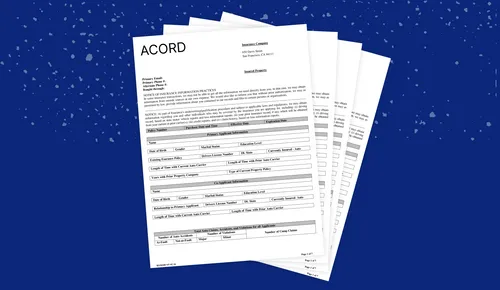Insurance companies rely heavily on underwriting as a key element of their business. It is through this process that they evaluate the risk associated with insuring a potential policyholder, enabling them to set premiums for coverage.
Friction in the submission process
Many insurance companies rely on manual processes - such as emails and phone calls - to collect submission data. This process often involves agents who must manually complete ACORD forms and exchange PDFs.
During the submission process, underwriters may require additional data from the policyholder to evaluate their risk. This can be tedious, as it is often hard to identify where each piece of information comes from and confirm its accuracy.
ACORD forms in underwriting
ACORD forms are standardized documents used in the insurance industry for various purposes. One of the main purposes of ACORD forms is to provide information for underwriting. These forms typically contain information about the policyholder and their insurance needs, as well as any relevant details about the coverage being requested.
ACORD stands for the Association for Cooperative Operations Research and Development. The organization was founded in 1970 with the goal of standardizing and streamlining communication in the insurance industry. The ACORD forms are designed to be easy to use and understand, and they are widely accepted by insurers, brokers, and other industry professionals.
ACORD forms contain important details about the policyholder and their insurance needs, which helps the underwriter assess the risk of insuring the policyholder and determine the appropriate premiums for their coverage.
ACORD forms can be sent to underwriters in a variety of formats, depending on the specific needs and preferences of the insurance company and the underwriter.
Here are a few examples of how agents might send filled ACORD forms to underwriters:
- Email: Agents can email the filled ACORD forms as a PDF or other electronic file to the underwriter.
- Online portals: Many insurance companies have online portals where agents can submit ACORD forms electronically. The underwriter can then access the forms through the portal and review them at their convenience.
- Fax: While less common these days than email or online portals, agents may also send filled ACORD forms to underwriters via fax.
- Physical copies: ACORD forms can also be sent as physical copies, such as a printed document or a copy on a CD or USB drive. This is usually done if the forms contain sensitive or confidential information that needs to be delivered in a secure manner.
The issue with manual data collection for underwriting
The main issue with manual submission processes and gathering of supplemental data is that they can be incredibly time-consuming and inefficient. For example, manually filling out ACORD forms can take a significant amount of time as the agent must review that they are filled out accurately and that the information provided is correct.
Still, if the form is missing any information or is filled out incorrectly, the underwriter might have to request additional information from the agent, and this can further delay the process.
Another issue is inefficient back-and-forth communications between agents, policyholders, and underwriters throughout the process. Having to manually track emails, phone calls, and PDFs can be a tedious process that could result in delays or mistakes, which could lead to underwriting issues such as declined applications.
Moreover, manually filling out submissions and ACORD forms can be tedious and leave room for error. This is especially true when dealing with a high number of submissions in a short amount of time. Data entry errors can not only slow down the process but also lead to costly mistakes that could have been avoided.

Resolving your submissions and supplemental data collection issues
Digital tools can help streamline the submission process by allowing agents to quickly gather customer data and fill out ACORD forms.
Digital data collection eliminates any need for manual data entry, as all the data is fed directly into your underwriting systems. This significantly reduces the potential for errors and improves accuracy. Moreover, digital tools can also automate certain parts of the process, such as collecting e-signatures from policyholders or sending reminders to agents when forms are due.
Digital solutions can also provide a unified platform where all parties involved in the underwriting process – agents, policyholders, and underwriters – can easily access, complete and track submissions. This cuts down on time-consuming manual processes and back-and-forth communications.
Requesting supplemental documentation and information is a breeze with automated forms and notifications.
Not only will you have better visibility into the data you're collecting, but you'll also be able to assess risk quickly and accurately. This way, you can make sure customers pay a fair rate for their coverage while avoiding any costly mistakes.
It is clear that manual data collection and submission processes can be time-consuming, inefficient, and prone to errors. However, digital solutions offer a more streamlined approach by automating certain parts of the process while providing visibility into customer data.
By using these tools, insurance companies can ensure they are collecting accurate information quickly and efficiently in order to assess risk correctly and make sure customers pay a fair rate for their coverage.
Insurance companies that utilize digital solutions for their underwriting processes can save time, resources, and money – all while significantly improving accuracy and reducing mistakes.
Ultimately, digital solutions are key when it comes to streamlining submissions and supplemental data collection in underwriting.





